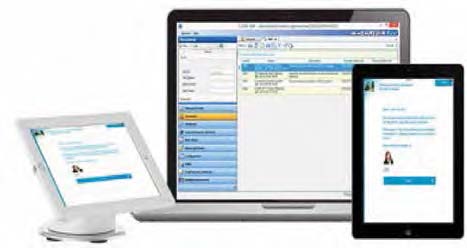Self-service kiosk application and automated workflows introduced with
version 2.60 & 2.60 SP1 of the C•CURE 9000 security and event management platform
 Johnson Controls introduces comprehensive and automated visitor management as a core component of the C•CURE 9000 security and event management platform with a new self-service kiosk application and optional stand offerings that connect through the C•CURE Portal. The new release provides auto-generation and assignment of temporary credentials for visitors, and customizable access control workflows for more efficient management of access credential requests.
Johnson Controls introduces comprehensive and automated visitor management as a core component of the C•CURE 9000 security and event management platform with a new self-service kiosk application and optional stand offerings that connect through the C•CURE Portal. The new release provides auto-generation and assignment of temporary credentials for visitors, and customizable access control workflows for more efficient management of access credential requests.
The latest version of the multi-integrative, highly flexible flagship C•CURE 9000 platform allows visitors to self-register using the new visitor management Kiosk Application for iOS iPad devices. Visitors now have the option of using a QR code to check-in instead of manually entering pertinent information into the application. Within C•CURE 9000, when the appropriate field is checked, the system generates a QR code for each visitor and for each visit. The visitor receives a confirmation email which includes a QR code image and a calendar attachment. Once the visitor arrives for check-in, he/ she simply presents the QR code at the kiosk and the information is prepopulated into the application. Once the visit is confirmed by C•CURE 9000 and a credential is created, a temporary identification label or card can be printed from the C•CURE 9000 client. An email notification of the visitor’s arrival is promptly sent to the host.
“The visitor management capabilities provided by the C•CURE 9000 visitor management kiosk and access management workflows, all from the C•CURE Portal, streamline and simplify everyday operations,” said Jason Ouellette, Product General Manager, Global, Access Control, Building Technologies & Solutions, Johnson Controls, “Visits are effectively managed by the kiosk even when front desk security personnel are unavailable. Security personnel can use the web-based, customizable access management workflows to automate and distribute the management of access requests and the initiation of changes to clearances.”
Using access management workflows, personnel records can be assigned as requestor and/ or approver’s roles and process clearance requests using customized rules and workflows. Clearance requests can be approved or denied by assigned approver without the need for adding operator accounts to C•CURE 9000, moving administrative tasks from security officers to individuals within the building for operational efficiency. Specific doors also can be configured to automatically initiate an access clearance request workflow based on how many times a card is rejected at the door. The C•CURE Portal creates an audit trail that documents all access approvals and requests, which is key for compliance controls.